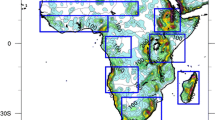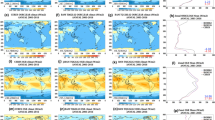Abstract
The Botswana High is a prominent mid-tropospheric system that modulates rainfall over subtropical southern Africa, but the capability of a global climate model (GCM) to reproduce it remains unknown. This study examines the capability of a GCM with quasi-uniform resolution (Model Prediction Across Scales, hereafter MPAS) in simulating the characteristics of the Botswana High. The MPAS is applied to simulate the global climate at 240 km quasi-uniform resolution over the globe for the period 1980–2010. The model results are validated against gridded observation dataset (Climate Research Unit, CRU), satellite dataset (Global Precipitation Climatology Project, GPCP), and reanalysis datasets (Climate Forecast System Reanalysis, CFSR; the National Oceanic and Atmospheric Administration, NOAA; and the European Centre for Medium-Range Weather Forecasts version 5, ERA5). In general, MPAS replicates all the essential features in the climatology of temperature, rainfall, 500 hPa geopotential height and vertical motion over southern Africa, reproduces the spatial and temporal variation of the Botswana High, and captures the influence of the Botswana High on droughts and deep convections over the sub-continent. In addition, the model reproduces well the anomalies in vertical motion over subtropical southern Africa during +ve and −ve phases of the Botswana High. However, the model struggles to reproduce the precipitation pattern associated with the positive and negative modes of the Botswana High. The results of this study have an application in understanding the characteristics of the Botswana High and in improving MPAS for seasonal forecasting over southern Africa.

















Similar content being viewed by others
Availability of data and material
All the data and materials used in this study can be freely made available on request.
Code availability
All the codes used in the study can be made available on request.
References
Abiodun BJ, Makhanya N, Petja B, Abatan AA, Oguntunde PG (2018) Future projection of droughts over major river basins in Southern Africa at specific global warming levels. Theor Appl Climatol 137(3–4):1785–1799. https://doi.org/10.1007/s00704-018-2693-0
Ali S, Dan L, Fu C, Yang Y (2015) Performance of convective parameterization schemes in Asia using RegCM: simulations in three typical regions for the period 1998–2002. Adv Atmos Sci 32(5):715–730. https://doi.org/10.1007/s00376-014-4158-4
Dong X, Fan FX, Lin RP, ** JB, Lian RX (2017) Simulation of the Western North Pacific subtropical high in El Niño Decaying Summers by CMIP5 AGCMs. Atmos Ocean Sci Lett 10(2):146–155. https://doi.org/10.1080/16742834.2017.1272404
Driver P, Reason CJC (2017) Variability in the Botswana high and its relationships with rainfall and temperature characteristics over Southern Africa. Int J Climatol 37:570–581. https://doi.org/10.1002/joc.5022
Driver P, Abiodun B, Reason CJC (2018) Modelling the precipitation response over southern Africa to the 2009–2010 El Niño using a stretched grid global atmospheric model. Clim Dyn 52:3929–3949. https://doi.org/10.1007/s00382-018-4362-5
Du Q, Faber V, Gunzburger M (1999) Centroidal Voronoi tessellations: applications and algorithms. SIAM Rev 41(4):637–676. https://doi.org/10.1137/S0036144599352836
Gore M, Abiodun BJ, Kucharski F (2020) Understanding the influence of ENSO patterns on drought over southern Africa using SPEEDY. Clim Dyn 54:307–327. https://doi.org/10.1007/s00382-019-05002-w
Harris IPDJ, Jones PD, Osborn TJ, Lister DH (2014) updated high-resolution grids of monthly climatic observations—the CRU TS3.10 dataset. Int J Climatol 34(3):623–642. https://doi.org/10.1002/joc.3711
He C, Zhou T (2015) Responses of the Western North Pacific subtropical high to global warming under RCP4.5 and RCP8.5 scenarios projected by 33 CMIP5 models: the dominance of tropical Indian Ocean-Tropical Western Pacific SST Gradient. J Clim 28(1):365–380. https://doi.org/10.1175/JCLI-D-13-00494.1
He C, Wu B, Zou L, Zhou T (2017) Responses of the summertime subtropical anticyclones to global warming. J Clim 30(16):6465–6479. https://doi.org/10.1175/JCLI-D-16-0529.1
Hohenegger C, Brockhaus P, Schaer C (2008) Towards climate simulations at cloud-resolving scales. Meteorol Z 17(4):383–394. https://doi.org/10.1127/0941-2948/2008/0303
Kasahara A (1959) A comparison between geostrophic and nongeostrophic numerical forecasts of hurricane movement with the barotropic steering model. J Meteorol 16(4):371–384. https://doi.org/10.1175/1520-0469(1959)016%3C0371:ACBGAN%3E2.0.CO;2
Klemp JB, Skamarock WC, Dudhia J (2007) Conservative split-explicit time integration methods for the compressible nonhydrostatic equations. Mon Wea Rev 135(8):2897–2913. https://doi.org/10.1175/MWR3440.1
Kramer M, Heinzeller D, Hartmann H, van den Berg W, Steeneveld GJ (2018) Assessment of MPAS variable resolution simulations in the grey-zone of convection against WRF model results and observations. Clim Dyn. https://doi.org/10.1007/s00382-018-4562-z
Lyu K, Yu J, Paek H (2017) The influences of the Atlantic multidecadal oscillation on the mean strength of the North Pacific subtropical high during Boreal winter. J Clim 30(1):411–426. https://doi.org/10.1175/JCLI-D-16-0525.1
Matarira CH (1990) Drought over Zimbabwe in a regional and global context. Int J Climatol 10(6):609–625. https://doi.org/10.1002/joc.3370100605
McEvoy DJ, Huntington JL, Abatzoglou JT, Edwards LM (2012) An Evaluation of multiscalar Drought indices in Nevada and Eastern California. Earth Interact 16(18):1–18. https://doi.org/10.1175/2012EI000447.1
McKee TB, Doesken NJ, Kleist J (1993) The relationship of drought frequency and duration to time scales. In: Proceedings of the 8th conference on applied climatology, vol 17, pp 179–183
Meque A (2015) Investigating the link between southern African droughts and global atmospheric teleconnections using regional climate models. In: Thesis, University of Cape Town. https://open.uct.ac.za/handle/11427/16686
Miyasaka T, Nakamura H (2010) Structure and mechanisms of the Southern Hemisphere Summertime subtropical anticyclones. J Clim 23(8):2115–2130. https://doi.org/10.1175/2009JCLI3008.1
National Center for Atmospheric Research Staff (Eds) (2017). Common Spectral Model Grid Resolutions. In: NCAR—Climate Data Guide. https://climatedataguide.ucar.edu/climate-model-evaluation/common-spectral-model-grid-resolutions. Accessed 13 Jan 2020
Paek H, Yu JY, Hwu JW, Lu MM, Gao T (2015) A SOURCE of AGCM bias in simulating the Western Pacific Subtropical high: different sensitivities to the two types of ENSO. Mon Wea Rev 143(6):2348–2362. https://doi.org/10.1175/MWR-D-14-00401.1
Prusa JM (2018) Computation at a coordinate singularity. J Comput Phys 361:331-352. https://doi.org/10.1016/j.jcp.2018.01.044
Reason CJC (2016) The Bolivian, Botswana, and Bilybara highs and southern hemisphere drought/floods. Geophys Res Lett 43(3):1280–1286. https://doi.org/10.1002/2015GL067228
Reason CJC (2018) Low-frequency variability in the Botswana High and southern African regional climate. Theor Appl Climatol 137(1):321–1334. https://doi.org/10.1007/s00704-018-2661-8
Ringler T, Ju L, Gunzburger M (2008) A multiresolution method for climate system modeling: application of spherical centroidal Voronoi tessellations. Ocean Dyn 58:475–498. https://doi.org/10.1007/s10236-008-0157-2
Rodwell MJ, Hoskins BJ (2001) Subtropical anticyclones and summer monsoons. J Clim 14(15):3192–3211. https://doi.org/10.1175/1520-0442(2001)014%3C3192:SAASM%3E2.0.CO;2
Skamarock WC, Klemp JB, Duda MG, Fowler LD, Park S (2013) Uniform and variable resolution nonhydrostatic global atmospheric simulations using Voronoi meshes in MPAS-atmosphere (Invited). In: AGUFM Abstract, pp A31H-01
Stowasser M, Wang Y, Hamilton K (2007) Tropical cyclone changes in the western North Pacific in a global warming scenario. J Clim 20(11):2378–2396. https://doi.org/10.1175/JCLI4126.1
Taylor MA, Edwards J, St Cyr A (2008) Petascale atmospheric models for the community climate system model: new developments and evaluation of scalable dynamical cores. J Phys: Conf Ser. https://doi.org/10.1088/1742-6596/125/1/012023
Thornthwaite CW (1948) An approach toward a rational classification of climate. Geogr Rev 38(1):55–94. https://doi.org/10.2307/210739
Unganai LS, Mason SJ (2002) Long-Range predictability of Zimbabwe summer rainfall. Int J Climatol 22(9):1091–1103. https://doi.org/10.1002/joc.786
Vicente-Serrano SM, Beguería S, López-Moreno JI (2010) A multiscalar drought index sensitive to global warming: the standardized precipitation evapotranspiration index. J Clim 23(7):1696–1718. https://doi.org/10.1175/2009JCLI2909.1
Washington WM, Buja L, Craig A (2008) The computational future for climate and Earth system models: on the path to petaflop and beyond. Phil Trans R Soc 367(1890):833–846. https://doi.org/10.1098/RSTA.2008.0219
Wu L, Wang B, Geng S (2005) Growing typhoon influence on East Asia. Geophys Res Lett 32:18. https://doi.org/10.1029/2005GL022937
Wu GX, Liu YM, Zhu XY, Li W, Ren R, Dua A, Liang X (2009) Multi-scale forcing and the formation of subtropical desert and monsoon. Ann Geophys 27(9):3631–3644. https://doi.org/10.5194/angeo-27-3631-2009
Zarzycki CM, Jablonowski C (2014) A multidecadal simulation of Atlantic tropical cyclones using a variable-resolution global atmospheric general circulation model. J Adv Model Earth Syst 6(3):805–828. https://doi.org/10.1002/2014MS000352
Acknowledgements
Computing facility was provided by the Centre for High-Performance Computing (CHPC, South Africa). We thank Phillip Mukwhena from the Climate Systems Analysis Group (CSAG), University of Cape Town for his help in installing the MPAS model on CHPC.
Funding
This project was supported with grants from the University of Cape Town PhD Staff Bursary.
Author information
Authors and Affiliations
Contributions
Both authors contributed to the study conception and methodology. Material preparation, data collection and analysis were performed by the first author under the supervision of the second author. The first draft of the manuscript was written by the first author and the second author was responsible for reviewing and editing previous versions of the manuscript. All authors read and approved the final manuscript.
Corresponding author
Ethics declarations
Conflicts of interest
Both authors declare that there is no conflict of interest and no competing interests.
Additional information
Publisher's Note
Springer Nature remains neutral with regard to jurisdictional claims in published maps and institutional affiliations.
Rights and permissions
About this article
Cite this article
Maoyi, M.L., Abiodun, B.J. How well does MPAS-atmosphere simulate the characteristics of the Botswana High?. Clim Dyn 57, 2109–2128 (2021). https://doi.org/10.1007/s00382-021-05797-7
Received:
Accepted:
Published:
Issue Date:
DOI: https://doi.org/10.1007/s00382-021-05797-7




